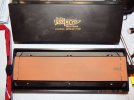Sharpening itself, and cleaning the stones used for sharpening, can be as complicated or as simple as one makes it out to be, in their mind. I've found it easier and more worry-free, long-term, to lubricate stones that are proven to work better as a result, and also proven easier to maintain in the best working condition as a result of lubricating them. Stone life and efficiency of cutting will be extended by lubricating the stone.
Most ceramic hones, due to the light touch-up nature of how they're used most of the time, can be maintained pretty well when used dry, using an eraser to clean them after each sharpening session (or even multiple times per session). But for the heavy loading that occurs when ceramics are used for heavier polishing, an application of 2 or 3 drops of mineral oil goes a long way toward keeping the stone cutting well, even as fairly heavy swarf accumulates. That's due to how the oil will prevent the swarf from clinging to the surface in almost a galling-like fashion, as happens when the stones are used dry. With just a little bit of oil, the swarf is essentially pushed aside as the honing occurs and can simply be wiped away with a rag. Sintered ceramics in particular, like the Spyderco hones, become exponentially slower when they begin to clog even a little bit. So, even if one can stay ahead of that with some eraser-scrubbing along the way, it'll have to be done very, very frequently to keep the hone working at all, in heavier grinding or polishing jobs.
Very coarse and very porous stones, like most oilstones (natural or synthetic) can't be cleaned fully to the depth of the pores with something like an eraser. Swarf will still accumulate below the eraser's reach and will still clog the stone to some degree over time. And it'll clog FAST, like in minutes, when used dry for any heavy grinding. And as with any lubrication used in friction-inducing work on a stone, the lubrication reduces wear as well, on the stone's grit. A stone that was designed and intended to be used with oil will almost never need any heavy scrubbing or cleaning between uses, and can simply be 'cleaned' by a light application of clean oil at the finish of the session, rubbed a bit into the surface to lift the swarf and wiped or blotted away with something like a microfiber towel. If maintained this way, the stone may never need any additional cleaning.
And decent diamond plates don't generate enough diamond dust to be of concern. Any dust that might be created, be it either loose grit or swarf, would be better controlled and contained with a little bit of lubrication, which will prevent the dust from getting airborne. And diamond plates are stupid-simple to clean in the same manner as an oilstone, used with a couple or three drops of oil on the surface. It keeps swarf from clinging, which means it can simply be wiped away with a microfiber towel. And the little bit of oil on the hone can be washed away when finished, with some dish soap & water - takes maybe 2 or 3 minutes. Alternatively, I sometimes use a spritz of Windex on a diamond hone in the same manner to clean it, wiping it off with the microfiber towel. All of this keeps the diamond plate working 'as new', when maintained this way. I DO sometimes use my diamond hones dry for some light tune-ups on the fly, done in maybe 2-5 passes per side. No big deal there, as loading/clogging issues go. But when I'm setting new bevels, I'll still put a few drops of oil on the diamond plate to keep the swarf from getting in the way. For cleaning's sake, that additional 'mess' might take an extra half-minute to clean up, as opposed to cleaning a dry hone.
Edited to add:
All the above, of my preferences and how & why I came to them, are the result of trying all of my hones/stones both with and without lubrication over the span of years. I've gone down the same path as well in specifically testing the differences in using either oil or water on stones. So, it's not like the conclusions I've reached are based on assumptions or short-term observations. I try to keep an open mind and I do revisit these things at times to see if I still come to the same conclusions or not. When I first started sharpening, I also felt the 'mess' aspect was something not worthwhile to me. But that was when I was doing all of my sharpening at a very light-duty, touchup scale, long before I started attempting tasks like reprofiling or setting new bevels on knives. For the light-duty work, one can get by without using lubrication on a stone and not notice much of an obvious difference. But for heavier work, the shortcomings in dry grinding vs. the improvement in performance coming with the extra 'mess' of wet sharpening kind of jump up and can't be ignored.


